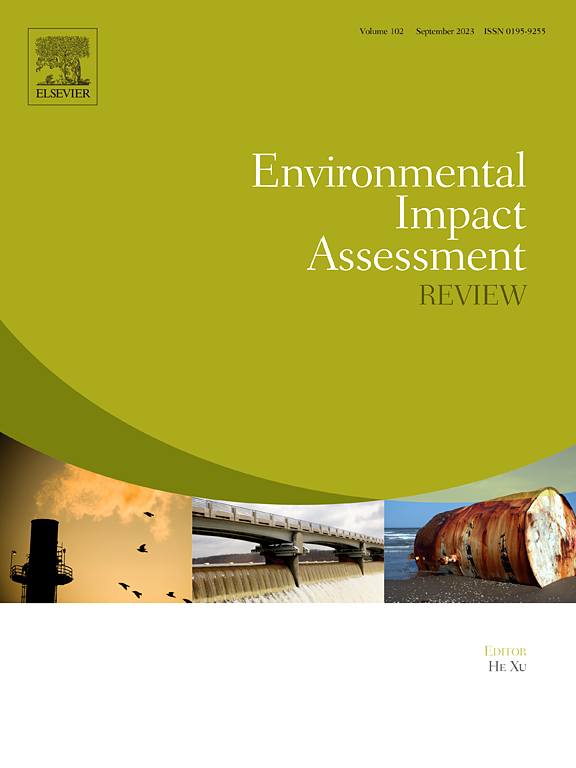Life cycle assessment of concrete with wind turbine blade waste: A real case study
IF 9.8
1区 社会学
Q1 ENVIRONMENTAL STUDIES
引用次数: 0
Abstract
Europe is among the most important wind-energy producers in the world, yet a commonly accepted solution is to be found towards Wind Turbine Blade Waste (WTBW) from wind turbine blades at the end of their lifespan. In this research, Life Cycle Assessment (LCA), regarding Global Warming Potential (GWP) and Abiotic Depletion Potential for fossil fuels (ADPf), was first used to study landfilling, incineration and mechanical recycling of WTBW. Mechanical recycling was highlighted as the best option, as incineration showed higher impacts (x4.5 GWP, x1.2 ADPf) and landfilling is forbidden by the European Union. Afterwards, WTBW management was combined with concrete production by considering both incineration and mechanical recycling, WTBW being used as aggregate replacement (2%, 5%, and 10% vol.) to create fiber-reinforced concrete. Mechanical recycling of WTBW always yielded lower results (-28.3% GWP, -5.9% ADPf), even when including larger transportation impacts in a real case in Castilla y León (-28.0% for GWP, -5.4% for ADPf), a region in Spain among the top producers of WTBW in Europe in the next 5-10 years, which is in need for a recycling strategy to follow. Lastly, four mechanical recycling plants would be needed in Castilla y León to minimize WTBW transportation impacts, thus the average environmental damage being reduced by 0.2% GWP and 0.3% ADPf per cubic meter of ready-to-cast concrete. These key findings emphasize the benefits of mechanically recycling WTBW and its potential when combined with concrete production through LCA, yielding promising results that can be implemented in different regions around the world.

风力涡轮机叶片废料混凝土的生命周期评估:一个真实案例研究
欧洲是世界上最重要的风能生产国之一,然而一个普遍接受的解决方案是在风力涡轮机叶片寿命结束时找到风力涡轮机叶片废物(WTBW)。本研究首次采用基于全球变暖潜势(GWP)和化石燃料非生物耗竭潜势(ADPf)的生命周期评价(LCA)方法对垃圾填埋、焚烧和机械回收进行了研究。机械回收被强调为最佳选择,因为焚烧显示出更高的影响(x4.5 GWP, x1.2 ADPf)和填埋被欧盟禁止。之后,通过考虑焚烧和机械回收,将垃圾垃圾管理与混凝土生产相结合,垃圾垃圾被用作骨料替代品(2%、5%和10%的体积)来制造纤维增强混凝土。在Castilla y León (GWP -28.0%, ADPf -5.4%)的实际案例中,机械回收的垃圾垃圾总是产生较低的结果(-28.3% GWP, -5.9% ADPf),即使包括更大的运输影响(GWP -28.0%, ADPf -5.4%),该地区位于西班牙,是未来5-10年欧洲最大的垃圾垃圾生产商之一,需要遵循回收策略。最后,Castilla y León将需要四个机械回收工厂来最大限度地减少垃圾运输的影响,因此,每立方米现浇铸混凝土的平均环境破坏减少0.2%的GWP和0.3%的ADPf。这些重要发现强调了机械回收垃圾的好处,以及通过LCA与混凝土生产相结合的潜力,产生了可以在世界不同地区实施的有希望的结果。
本文章由计算机程序翻译,如有差异,请以英文原文为准。
求助全文
约1分钟内获得全文
求助全文
来源期刊

Environmental Impact Assessment Review
ENVIRONMENTAL STUDIES-
CiteScore
12.60
自引率
10.10%
发文量
200
审稿时长
33 days
期刊介绍:
Environmental Impact Assessment Review is an interdisciplinary journal that serves a global audience of practitioners, policymakers, and academics involved in assessing the environmental impact of policies, projects, processes, and products. The journal focuses on innovative theory and practice in environmental impact assessment (EIA). Papers are expected to present innovative ideas, be topical, and coherent. The journal emphasizes concepts, methods, techniques, approaches, and systems related to EIA theory and practice.
 求助内容:
求助内容: 应助结果提醒方式:
应助结果提醒方式:


